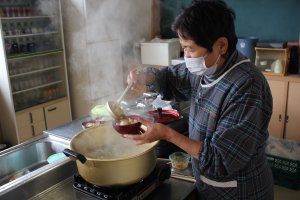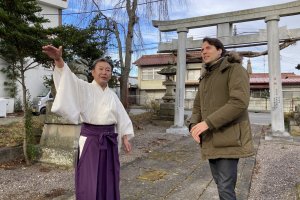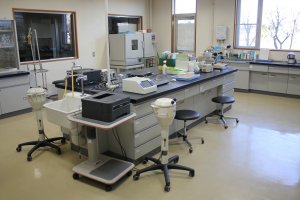The Ouse district of Koriyama City is a world away from the bustle of hectic urban life. Sloping mountains cradle the extensive rice paddies and other farmland in this small town of 3,000 that sits at the geographic center of Fukushima Prefecture in Japan’s Tohoku region.
Ouse bills itself as “the town for encounters,” playing off the kanji character for “encounter” in the “Ou” part of its name. I’ve taken an 80-minute Shinkansen ride from Tokyo to Koriyama Station, then driven another 30 minutes to make some encounters of my own through the town’s Ouse-Inaka Experience Exchange program.
The program offers home-away-from-home stays in Ouse with a range of activities for people to choose from. It started off as a hit with Japanese university students, but it quickly expanded to include international exchange students looking for a taste of a more traditional way of life, and now even visitors from abroad have discovered its appeal.
What to expect
Stepping inside the headquarters of the Ouse Rural Tourism Association, I quickly find myself being treated like a traveler coming home rather than one making a first visit. Greeting me with exuberant smiles, several farmwives beckon me over to the kitchen to inspect a large pot of miso soup brimming with assorted vegetables fresh from their fields and gardens.

As we prepare for lunch, my hosts, Mses. Ishii, Sato, and Makabe, teach me how to mold my own onigiri (rice balls). The heat of the freshly cooked rice warms my hands as I tuck into the rice such ingredients as salted plum and miso, which they have prepared earlier.

Over the delicious home-style cooking, we soon get to know each other—and I get to know Ouse itself. While we later stroll outside to admire the views of the surrounding rice fields that extend far along the horizon, Ms. Ishii shares stories about her childhood growing up in the hills, helping her family tend the terrace rice fields. Before long, I begin to appreciate the pastoral landscape from her perspective.
Tadano Moto Jinja
We then take a short walk over to Tadano Moto Jinja, a Shinto shrine with deep roots in Ouse, evident from the 800-year-old zelkova tree near the main approach. Mr. Ando, the shrine’s kannushi (chief priest), meets us to point out various aspects of the shrine. He describes the architectural elements on the old wooden structure and explains all about the unique torii gate with its six pillars. He pays particular attention to the magnificent stone komainu (lion-dogs), whose eyes he painted in his youth.

As someone still learning about the finer points of Japan’s native religion, I find that speaking with Mr. Ando about Shinto history and practices proves invaluable. He not only explains the customs of worshipping at a shrine but also answers my questions about the deities enshrined here—Hi-no-yagihayawo-no-kami, the god of fire, and Kamakura Gongoro Kagemasa, a samurai from the Heian period (794–1185) known for his skill in combat.
Koriyama City Horticultural Promotion Center
Later on, we tour the Koriyama City Horticultural Promotion Center. Operated by the city government, this facility supports local farmers in using their extensive plots and greenhouses to test new crops or teach best agricultural practices. It also offers opportunities for the general public to experience planting and harvesting.

Ever since the March 2011 earthquake and tsunami, which crippled the Fukushima Daiichi Nuclear Power Plant on the coast, the center has taken on a new role: measuring radiation levels in local crops. The head of the center notes that radiation levels dropped significantly right after the disaster. While radiation is still being detected in the mountains (for example, in wild mushrooms), food produced by Ouse farmers in rice paddies and fields has consistently proved safe for consumption.

Jodomatsu Park
As the day slowly gives way to dusk, there is just enough light to catch some unique natural scenery and a great view of the sunset at Jodomatsu Park. The grounds include a wide, grassy lawn with stalls for barbecuing and some playground equipment, but the real draw is a short hike away in the surrounding foothills. Numerous signs point the way to the Kinoko-Iwa (mushroom rocks), a series of oddly shaped boulders that definitely resemble mushrooms.

The sparsity of plants between the boulders and the majestic pines that have dug tenaciously into the stone crevices evoke the pine-covered islands of Miyagi Prefecture’s Matsushima, which is why the spot is nicknamed “Matsushima on the Shore.” Beyond the beautiful scenery, however, I’m captivated by the entertaining stories shared by my guides. Mr. Ishii, a local farmer, and Ms. Sato talk of how they relished playing around these boulders and sledding here in their childhood.
Yasumi-ishi Onsen
Though participants on farmstays may lodge with one of Ouse’s families, my accommodation tonight is a hot spring with some incredible history, Yasumi-ishi Onsen. According to local lore, the Heian-period military commander Hachimantaro Yoshiie once rested (yasumi) on a stone (ishi) here and gazed down at the natural hot spring bubbling out below.

Soothing indoor and outdoor baths make this a popular place for day visitors. But overnight guests can look forward to spacious Japanese-style rooms complete with tatami mats and shoji doors, as well as lovely views of the greenery in the small gorge nearby. The facility has also made a name for itself with its signature dish featuring carp—a local specialty—made using a recipe perfected over six generations.
Nandabe-mura Agriculture Experiences
The next morning, Mr. Ishii drives me over to Nandabe-mura, the site of his home, extensive farm, and specially-built facilities for workshops and other activities. In preparation for lunch, we first head out to his garden to harvest fresh burdock root and taro and then wheelbarrow them over to the outdoor kitchen. He then teaches me how to split wood successfully and get the fire started in an outdoor stove where we will boil the vegetables.

Soon we’re ready for the day’s highlight and a staple of Japanese culture, pounding mochi. Freshly cooked and sticky mochi rice is placed into a wooden mortar called an usu, then pounded smooth with a kine (wooden mallet). As I catch my breath between swings, the farmers, watching in amusement, tell me that this activity is also a tradition in Ouse wedding ceremonies.

Once the mochi is ready, the women serve up a veritable feast starring Ouse’s local specialty of cabbage mochi, as well as mochi with tofu and walnuts or with anko (red-bean paste). There is also tempura, miso soup with the vegetables harvested earlier, and a healthy dessert of fresh, crisp apples and sweet mandarin oranges

With all the excitement of the day’s activities, I feel that the time for my departure comes much too soon. As I bid farewell to my hosts, we already start discussing ideas for a possible return visit, and I am sent off with extra mochi and other leftovers from lunch to take home. In fact, I leave Ouse feeling much the same as when I arrived—like a member of the family.


































